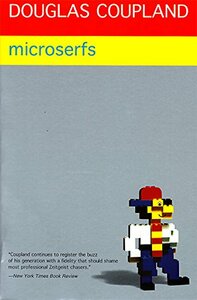You need to sign in or sign up before continuing.
Take a photo of a barcode or cover
adventurous
funny
lighthearted
reflective
slow-paced
Plot or Character Driven:
A mix
Strong character development:
Complicated
Loveable characters:
Yes
Diverse cast of characters:
No
Flaws of characters a main focus:
Complicated
medium-paced
Plot or Character Driven:
A mix
Strong character development:
Yes
Loveable characters:
Yes
Diverse cast of characters:
Yes
Flaws of characters a main focus:
No
This book was everything to me in 1995. It’s my only regret that I didn’t see this as the only signal I needed to move to Palo Alto or Redmond. Or major in CS and HCI. Or become a published writer by now.
This is a book that would be in my time capsule and heirlooms for my future generations.
This is a book that would be in my time capsule and heirlooms for my future generations.
I read this back in the day - in hard cover form! - and remember it struck me as an anthem to everything that was/is wrong with corporate culture not just geek life. The all absorbing work of making money for somebody else and the empty existence it provides us in exchange. It begged the question "why?" And I'm not sure that we've really answered it.
lighthearted
reflective
medium-paced
Plot or Character Driven:
Character
Strong character development:
Yes
Loveable characters:
Yes
Diverse cast of characters:
Yes
Flaws of characters a main focus:
Yes
inspiring
lighthearted
relaxing
medium-paced
Plot or Character Driven:
Character
Strong character development:
Yes
Loveable characters:
Yes
Diverse cast of characters:
Yes
Flaws of characters a main focus:
No
funny
reflective
sad
medium-paced
Plot or Character Driven:
Character
Strong character development:
Yes
Loveable characters:
Yes
Diverse cast of characters:
No
Flaws of characters a main focus:
No
This epistolary novel about nerdy programmers working for Microsoft in the '90s suprised me. I wasn't sure I would like it (or even really understand it, since I'm not a computer nerd) but it was very funny and also quite touching. It's written in the form of PowerBook diary entries; the narrator's random observations about work, his housemates, and their day-to-day lives made me chuckle. Although this book may seem silly at first, it carries a poignant throughline about the narrator's little brother, who died in a tragic accident during their childhood, leaving a deep void in his family's hearts. There were a couple moments that brought tears to my eyes. I've never read anything quite like this and I'm really glad I got to know these characters.
funny
lighthearted
mysterious
reflective
slow-paced
Plot or Character Driven:
Character
Strong character development:
Yes
Loveable characters:
Yes
Diverse cast of characters:
Yes
Flaws of characters a main focus:
Yes
emotional
funny
lighthearted
reflective
slow-paced
It's as if you had Silicon Valley in the 90's. Incredibly funny and pertinent at times when mentioning the privatization of the private. Coupland is a nerd with a big ole heart that comes of as sappy at times, which I love.





